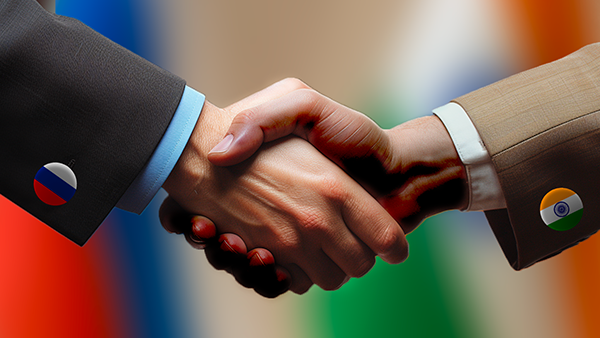
The third leg of the stool of Russian-Indian relations
By Alex Kupriyanov
Before the launch of the SMO, at Russian-Indian expert meetings, someone used to liken bilateral relations to a three-legged stool: two of the three legs - political, economic and cultural - were firmly in place, but the structure could only be stable if a third leg was eventually added. There have been problems with this for a long time: trade turnover has grown slowly and, even in the feverish post-covid recovery, has barely exceeded $12 billion.
Although India's financial year does not coincide with the calendar year and begins on the night of 1 April, it is already clear that Santa Claus has brought the Indian economy an excellent gift under the palm tree. Trade turnover with Russia in the current fiscal year will apparently exceed $60 billion - and this does not include the so-called hidden trade turnover, i.e. that which is transacted through third countries such as Turkey, the United Arab Emirates, China, Singapore and Iran. Apparently, it will cost another $8-10 billion.
The reason for this increase is obvious: oil. Sanctions imposed after the launch of the US/EU/G7 cut Russia off from European markets, and Russian hydrocarbons flowed eastwards, including to India. In the first months after the conflict broke out, Western leaders tried to pressure New Delhi, arguing that India, as the world's largest democracy, should join the Western bloc and stop all trade with Moscow. But this pressure soon eased. It became clear that a quick victory over Russia on the battlefield would not be achieved; the world system began to adapt to the changed conditions, and the Western leadership discovered that in the new reality, not only how much money Russia will receive from oil exports, but also the survival of the Western countries themselves depends on the intermediary countries - India, China, Turkey, the UAE and Singapore economies. In fact, many neutral states now play the role of parts of a giant pump that ensures the transfer of Russian resources to the West, and Western technologies, products and investments to Russia. And, of course, they do not forget their own interests.
One often hears that redirecting oil flows to the East is economically unprofitable for Russia. This is partly true, but the problem is that the choice is not between trading with the East or the West, but between trading with the East and not trading at all. Russia missed the chance to enter the Asian market on the most favourable terms in the late 1980s and early 1990s. Now Moscow is only expected to be a supplier of energy resources; if Russia manages to gain a foothold in the eastern markets, we can think about further expanding its presence.
The main problem for Russia is that this pump is now working unevenly. It has proved much easier to redirect the flow of oil than the flow of investment and technology that the Russian economy needs. As a result, the imbalance in Russian-Indian trade, which has existed throughout the history of bilateral relations, has grown to enormous proportions: at the end of September, the total volume of trade reached $50 billion, with a trade deficit for India of $43 billion. The only way to rectify this situation is to invest money and effort consistently and purposefully in setting up joint ventures with Indians and creating mechanisms for circumventing sanctions through third countries. This requires the development and implementation of a bilateral programme under which both Moscow and New Delhi would provide all possible assistance and preferences to joint ventures. Without it, the process of redressing the imbalance will continue, but at a much slower pace.
Russian-Indian relations have passed the test of strength under crisis conditions, but a new test lies ahead. The Ukrainian conflict will end sooner or later, and there is a good chance that by then Western elites will see the world a little more soberly and agree to a partial lifting of sanctions. This means that there will be no need for India as an intermediary, and Russian-Indian trade will collapse as quickly as it grew. The more Russian companies manage to gain a foothold in the Indian market by then, the less painful this fall will be. India is valuable in its own right, not just as an intermediary: in the foreseeable future it will become the world's third largest economy and one of its largest markets. The more money, resources and effort Russia puts into India now, the more impressive the dividends will be later.
This article originally appeared at iz.ru and was translated and edited by Rhod Mackenzie
